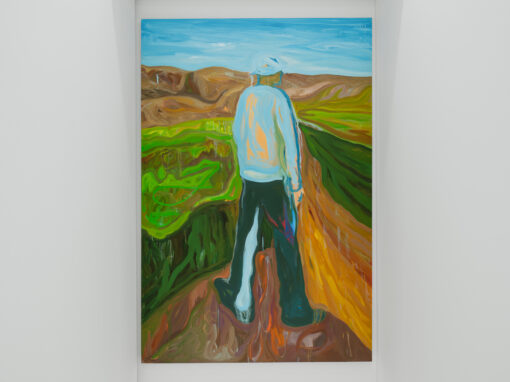Roamers
Sangwon Kwak
Traversing the boundary between painting and drawing, Sangwon Kwak creates figure paintings with bold outlines drawn with charcoal, or oil paintings with intense textures formed by thick layers of paint. Combining different layers, methods, and attitudes, all of Kwak’s works convey their own distinctive moods, sensibility, and emotions. Nevertheless, they are linked by certain formal consistencies, such that each painting seems to represent the apex of an unspecified narrative. For example, The Catcher (2013) shows the silhouette of a person standing on a ridge and pointing a gun at an unseen target. Despite the lack of visual clues, the title subtly suggests that the person is some type of guardian or protector engaged in a defensive maneuver. Channel of Fragments (2019) consists of thick line drawings framed inside panels, resembling comics or animation cells, emphasizing the discontinuity of the scenes. Unable to elucidate the underlying narrative connecting these scenes, we can only read them as an “open narrative.”
Many of Kwak’s works feature a lone figure standing or walking in a forest or field. Works with ambiguous titles such as Roamer (2018) or Person Standing (2020) contain simple figures who are backlit or turning their backs to the viewer to conceal their identity. The choice of texture and light in these works is particularly interesting. In Roamer, for example, a person walking a dark forest path is surrounded by concentric circles of black and white expressed with spiraling lines of charcoal. Occupying a secluded space of loneliness and alienation, the figure is clearly positioned as a symbolic subject. He crosses a stage designed especially for him, like a character from a Samuel Beckett play. Meanwhile, in Person Standing, the figure stands a step away from a circle on the floor, while melting into the background of blue light like a ghost. To create this effect, the artist first produced a pictorial plane with a strong texture, before scribbling in the background and figure with lines of blue paint. In this way, the narrative elicits a completely different pictorial order and method.
Born in 1983, Sangwon Kwak grew up in a period marked by dramatic economic swings, social polarization, and ideological conflicts. This context might help to explain the figures in paintings such as Full Moon Day (2014), who seem to be wandering through dangerous traps or swamps with no clear direction or destination. From Fragments (2019) shows two figures with arms interlocked, one of whom is sinking into a bog or whirlpool. Because of the simple expression of the arms and hands, however, it is impossible to tell whether the standing person is trying to save or to drown the sinking person. Other works are haunted by people concealed in the background, as if witnessing a scene without intervening. In Contact (2019), two figures face one another in a chaotic, post-apocalyptic scene. One of the figures appears to be dead, while the other may be blind. Whether these two are the same person or different people, they are clearly entrapped and unable to move in the surrounding space, as if entangled in the sharp branches of a forest.
In more recent works, the figures have become vague traces or faint silhouettes trapped between stones, as in My Stone (2020), or within tree branches and vines, as in Treefingers (2021). This progression was predicted by Engraved Face (2020), in which the frozen facial expressions of people who disappeared into the swamp are smudged into the surrounding landscape, indistinguishable from the ground. Only by looking very carefully can viewers discern the angry expression of a person with eyes wide open, located in the middle of the upper part of the painting. Some of Kwak’s recent figure paintings seem to depict the ghosts of those who have returned from these depths. My Blue (2018) shows a white faceless figure with water leaking from the chest, like a drowning victim. On the other hand, the sharp lines might also be the leaves of plants piercing the body. The red silhouette in Youth (2021) holds a long pole and breaks through the horizon at the neck, as if burning with the passions of youth. Finally, the ghostly figure in My Land (2021) wears a hat that merges with the surrounding sky, such that the distant hills are visible through his transparent head. His back seems to be soaked with sweat, while the left leg of his pants is also wet. Hesitating, the person must inevitably make his way through the green fields to his desolate land. Such narratives clearly reveal Sangwon Kwak’s feelings towards a bygone era. Where will all the people who are seeking “their land” go now?
“Rather than pursuing realistic representations of specific objects as seen through careful observation, Sangwon Kwak captures traces of objects that have passed through the nerves of the retina, as if confirming some vague memory their presence. Each of his paintings testifies to the act of roaming. While it seems certain that he must have visited the actual site, the purpose of the visit is unknown. Therefore, his canvases are filled with desolation. As Kwak said, ‘I don’t think anything can stay where it is forever. I wonder if work, love, feelings, status, and relationships are all just passing by.’ Perhaps the sole purpose of Kwak’s actions is to show that the time and space in his paintings is not his own. In objectifying the time and space around him, the artist excavates the source of anxiety.”
Seokgwon Hwang












